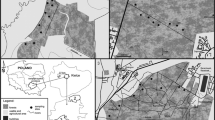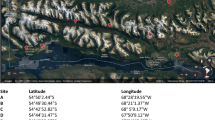Abstract
Various methods are currently used to prepare moss samples prior to their analysis in biomonitoring surveys. To date there has been no investigation of whether different results are obtained by using different preparation techniques. We therefore selected three preparation procedures (freezing, drying and acclimatization), currently applied in the European Moss Survey and other studies, to test whether significantly different concentrations of Al, As, Cd, Cr, Cu, Fe, Hg, K, Ni, Pb, Se, V and Zn are obtained. In addition, we considered the effect that the degree and type of contamination of the sampling sites and the different times of the year may have on the results. We found significant differences in the concentrations of all elements in the moss samples subjected to the different procedures and recommend standardization of the methods of sample preparation for valid comparison of the results. We further recommend that the samples are picked over directly in the field, to remove adhering material, and then cleaned prior to analysis.
Similar content being viewed by others
References
Aboal, J. R., Couto, J. A., Fernández, J. A., & Carballeira, A. (2006). Two important aspects of the moss technique: Definition and number of subsamples. Archives of Environmental Contamination and Toxicology, 50, 88–96.
Aceto, M., Abollino, O., Conca, R., Malandrino, M., Mentasi, E., & Sarzanini, C. (2003). The use of mosses as environmental metal pollution indicators. Chemosphere, 50, 333–342.
Äyräs, M., Niskavaara, H., Bogatyrev, I., Chekushin, V., Pavlov, V., de Caritat, P., et al. (1997). Regional patterns of heavy metals (Co, Cr, Cu, Fe, Ni, Pb, V and Zn) and sulphur in terrestrial moss samples as indication of airborne pollution in a 188,000 km2 area in northern Finland, Norway and Russia. Journal of Geochemistry Exploration, 58, 269–281.
Bargagli, R., Brown, D. H., & Nelli, L. (1995). Metal biomonitoring with mosses: Procedures for correcting for soil contamination. Environmental Pollution, 89, 169–175.
Bates, J. W. (1997). Effects of intermittent desiccation on nutrient economy and growth of two ecologically contrasted mosses. Annals of Botany, 79, 299–309.
Berg, T., Røyset, O., & Steinnes, E. (1995). Moss (Hylocomium splendens) used as biomonitors of atmospheric trace elements deposition: Estimation of uptake efficiencies. Atmospheric Environment, 29, 353–360.
Berg, T., & Steinnes, E. (1997). Recent trends in atmospheric deposition of trace elements in Norway as evident from the 1995 moss survey. Science of the Total Environment, 208, 197–206.
Berlekamp, J., Herpin, U., Matthies, M., Lieth, H., Markert, B., Weckert, V., et al. (1998). Geographic classification of heavy metal concentrations in mosses and stream sediments in the Federal Republic of Germany. Water Air and Soil Pollution, 101, 177–195.
Brown, D. H., & Wells, J. M. (1990). The extracellular and intracellular uptake of inorganic chemicals by bryophytes. In H. D. Zinsmeister & R. Mues (Eds.), Bryophytes, their chemistry and chemical taxonomy (pp. 298–318). Oxford: Clarendon.
Buse, A., Norris, D., Harmens, H., Büker, P., Ashenden, T., & Mills, G. (2003). Heavy metals in European mosses: 2000/2001 survey. Bangor, United Kingdom: UNECE ICP Vegetation.
Cenci, R. M. (1998, November). L’utilizzo di muschi indigeni e trapiantati: proposta di normativa. Paper presented at the workshop Biomonitoraggio della qualita dell’aria sul territorio nazionale, Roma.
Davis, D. D., McClenahen, J. R., & Hutnik, R. J. (2001). Use of an epiphytic moss to biomonitor pollutant levels in southwestern Pennsylvania. Northern Naturalist, 8, 379–392.
Ermakova, E. V., Frontasyeva, M. V., & Steinnes, E. (2004). Air pollution studies in Central Russia (Tula Region) using the moss biomonitoring technique, INAA and AAS. Journal of Radioanalitycal Nuclear Chemistry, 259, 51–58.
Fernández, J. A., Aboal, J. R., Couto, J. A., & Carballeira, A. (2002). Sampling optimization at the sampling-site scale for monitoring atmospheric deposition using moss chemistry. Atmospheric Environment, 36, 1163–1172.
Fernández, J. A., Aboal, J. R., Couto, J. A., & Carballeira, A. (2004). Moss bioconcentration of trace elements around a FeSi smelter: Modelling and cellular distribution. Atmospheric Environment, 38, 4319–4329.
Fernández, J. A., Rey, A., & Carballeira, A. (2000). An extended study of heavy metal deposition in Galicia (NW Spain) based on moss analysis. Science of the Total Environment, 254, 31–44.
Galsomiès, L., Letrouit, M., Deschamps, C., Savanne, D., & Avnaim, M. (1999). Atmospheric metal deposition in France: Initial results on moss calibration from the 1996 biomonitoring. Science of the Total Environment, 23, 39–47.
García, O. (2003). Biocontrol y modelización de la contaminación por elementos traza en el entorno de un metalurgia de FeSi (Ferroatlántica Dumbría). Universidad de Santiago de Compostela: Proyecto Fin de Carrera, Graduado Superior en Ingeniería Ambiental.
Gerdol, R., Bragazza, L., Marchesini, R., Alber, R., Bonetti, L., Lorenzoni, G., et al. (2000). Monitoring of heavy metal deposition in Northern Italy by moss analysis. Environmental Pollution, 108, 201–208.
Halleraker, J. H., Reimann, C., de Caritat, P., Finne, T. E., Kashulina, G., Niskavaara, H., et al. (1998). Reliability of moss (Hylocomium splendens and Pleurozium schreberi) as a bioindicator of atmospheric chemistry in the Barents region: Interspecies and field duplicate variability. Science of the Total Environment, 218, 123–139.
Herpin, U., Berlekamp, J., Markert, B., Wolterbeek, B., Grodzinska, K., Siewers, U., et al. (1996). The distribution of heavy metals in a transect of the three states The Netherlands, Germany and Poland, determined with the aid of moss monitoring. Science of the Total Environment, 187, 185–198.
Knulst, J. C., Westling, H. O., & Brorström-Lundén, E. (1995). Airborne organic micropollutant concentration in mosses and humus as indicators for local versus long-range sources. Environmental Monitoring and Assessment, 36, 75–91.
Kuik, P., & Wolterbeek, H. Th. (1995). Factor analysis of atmospheric trace-element deposition data in The Netherlands obtained by moss monitoring. Water Air and Soil Pollution, 84, 323–346.
Markert, B., Herpin, U., Berlekamp, J., Oehlmann, J., Grodzinska, K., Mankovska, B., et al. (1996a). A comparison of heavy metal deposition in selected Eastern European countries using moss monitoring method, with special emphasis on the ‘Black-Triangle.’Science of the Total Environment, 193, 85–100.
Markert, B., Herpin, U., Siewers, U., Berlekamp, J., & Lieth, H. (1996b). The German heavy metal survey by means of mosses. Science of the Total Environment, 182, 159–168.
Niskavaara, H., Reimann, C., & Chekushin, V. (1996). Distribution and pathways of heavy metals and sulphur in the vicinity of the copper-nickel smelters in Nikel and Zapoljarnij, Kola Peninsula, Russia, as revealed by different sample media. Applied Geochemistry, 1, 25–34.
Poikolainen, J., Kubin, E., Piispanen, J., & Karhu, J. (2004). Atmospheric heavy metal deposition in Finland during 1985–2000 using mosses as bioindicators. Science of the Total Environment, 318, 171–185.
Reimann, C., de Caritat, P., Halleraker, J. H., Finne, T. E., Boyd, R., Jæger, Ø., et al. (1997). Regional atmospheric deposition patterns of Ag, As, Bi, Cd, Hg, Mo, Sb and Tl in a 188,000 km2 area in the European Artic as displayed by terrestrial moss samples — Long-range atmospheric transport vs. local impact. Atmospheric Environment, 31, 3887–3901.
Riget, F., Asmund, G., & Aastrup, P. (2000). The use of lichen (Cetraria nivalis) and moss (Rhacomitrium lanuginosum) as monitors for atmospheric deposition in Greenland. Science of the Total Environment, 245, 137–148.
Rühling, ü. (Ed.). (1994). Atmospheric heavy metal deposition in Europe estimation based on moss analysis, vol. 9 (p. 53). Copenhagen: NORD.
Rühling, ü., & Steinnes, E. (Eds.). (1998). Atmospheric heavy metal deposition in Europe 1995–1996, vol. 15 (p. 66). Copenhagen: NORD.
Schilling, J. S., & Lehman, M. (2002). Bioindication of atmospheric heavy metal deposition in the Southeastern US using the moss Thuidium delicatum. Atmospheric Environment, 36, 1611–1618.
Steinnes, E., Rambæk, J. P., & Hanssen, J. E. (1992). Large scale multi-element survey of atmospheric deposition using naturally growing moss as biomonitor. Chemosphere, 25, 735–752.
Thöni, L., & Hertz, J. (1992). Applicability of the moss Hypnum cupressiforme for biomonitoring of heavy metals: 1. An investigation of the site requirements. In E. Merian & W. Haerdi (Eds.), Metal compounds in Environment and Life. Interrelation between Chemistry and Biology (pp. 137–151). Northwood: Science and Technology Letters.
Thöni, L., Schnyder, N., & Krieg, F. (1996). Comparison of metal concentrations in three species of mosses and metal freights in bulk precipitations. Fresenius Journal of Analytical Chemistry, 354, 703–708.
Wolterbeek, H. T., Kuik, P., Verburg, T. G., Herpin, U., Markert, B., & Thöni, L. (1995). Moss interspecies comparisons in trace elements concentrations. Environmental Monitoring and Assessment, 35, 263–286.
Zar, J. H. (1984). Biostatistical analysis. London: Prentice-Hall.
Author information
Authors and Affiliations
Corresponding author
Rights and permissions
About this article
Cite this article
Aboal, J.R., Fernández, J.A., Couto, J.A. et al. Testing differences in methods of preparing moss samples. Environ Monit Assess 137, 371–378 (2008). https://doi.org/10.1007/s10661-007-9772-5
Received:
Accepted:
Published:
Issue Date:
DOI: https://doi.org/10.1007/s10661-007-9772-5




